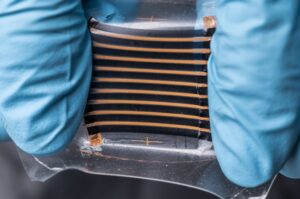
New stretchable, conductive composite material for wearable applications
Canadian Plastics
Materials Research & DevelopmentDeveloped by researchers at Sweden's Linköping University, the material may have widespread use in smart clothing, wearable electronics, and electronic skin.

The material is stretchable in two dimensions. Photo Credit: Thor Balkhed/ Laboratory of Organic Electronics at Linköping University
A new composite material goes comic book character Plastic Man one – and maybe even two – better: not only is it stretchable, but it also has a high electrical conductivity and good thermoelectric properties.
Developed by researchers at the Laboratory of Organic Electronics at Linköping University, in Linköping, Sweden, the material may have widespread use in smart clothing, wearable electronics, and electronic skin.
According to Nara Kim, a post-doctoral student and principal research engineer at Linköping University’s Laboratory of Organic Electronics, has combined three materials: the conducting polymer PEDOT:PSS, a water-soluble polyurethane rubber, and an ionic liquid. The result is a composite with unique properties – the PEDOT:PSS gives it thermoelectric properties, the rubber provides elasticity, and the ionic liquid ensures softness.
PEDOT:PSS is the most common conducting polymer, and is used in many applications because of its good thermoelectric properties. But the downside is, the thick polymer film is too hard and brittle to be successfully integrated into wearable electronics. “Our material is 100 times softer and 100 times more stretchable than PEDOT:PSS”, said research team member Klas Tybrandt. “The ability to control the structure of the material both at the nanoscale and the microscale allows us to combine the excellent properties of the different materials in a composite.”
The new composite is also printable, Tybrandt added, and can be printed onto various surfaces. When the surface flexes or folds, the composite follows the motion. And the process to manufacture the composite is cheap and environmentally friendly.
The researchers see a huge range of new possibilities using the material to create soft and elastic organic conducting materials. “There are many ionic liquids, conducting polymers and traditional elastomers that can be combined to give new nanocomposites for many applications, such as thermoelectric generators, supercapacitors, batteries, sensors, and in wearable and implantable applications that require thick, elastic and electrically conducting materials”, said team member Xavier Crispin.
Principal financers of the research have been the Knut and Alice Wallenberg Foundation, the Göran Gustafsson Foundation, and the Swedish Foundation for Strategic Research, together with the strategic research area in advanced functional materials, AFM, at Linköping University.
Source: Linköping University
